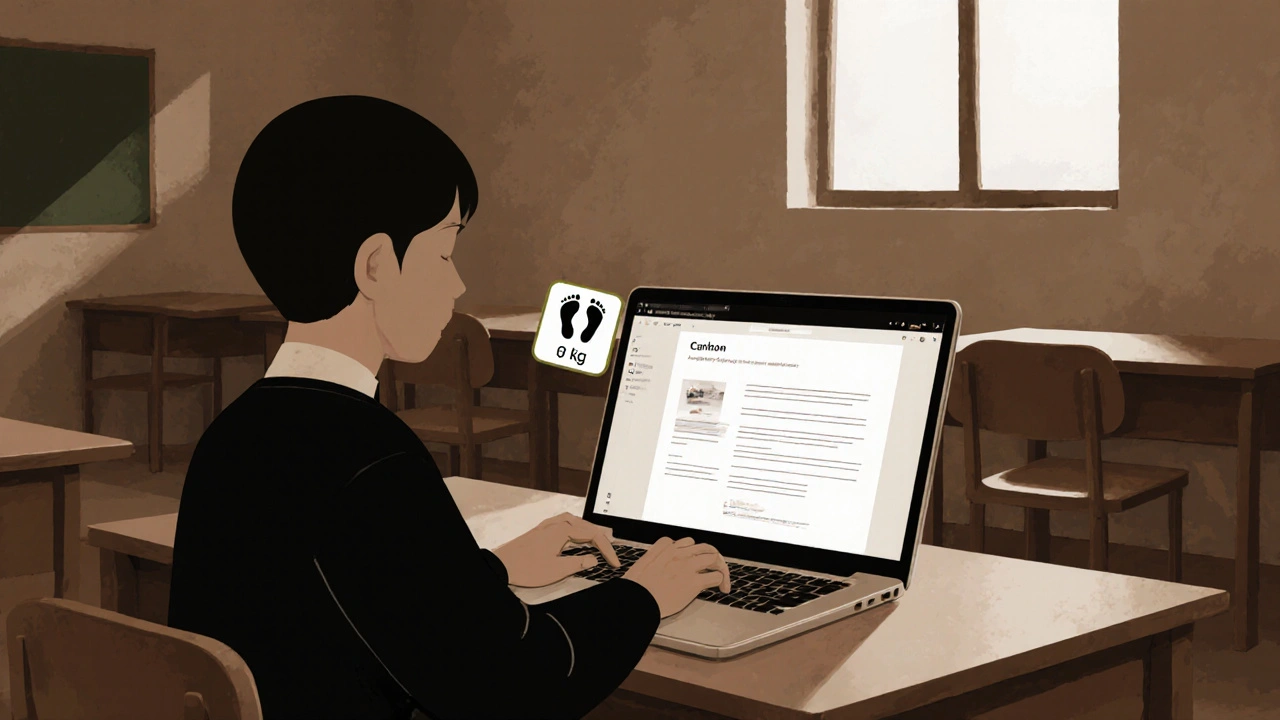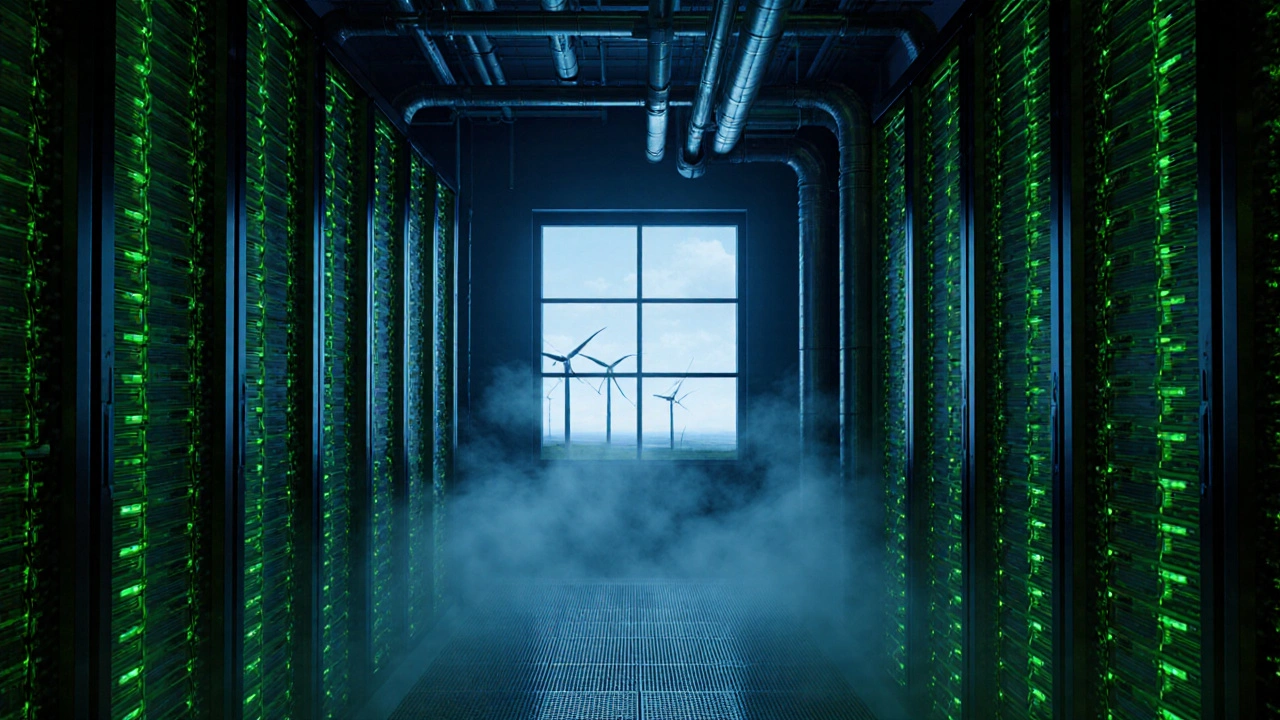By 2025, online learning platforms are responsible for more carbon emissions than the entire aviation industry in some regions. That’s not a guess - it’s from a 2024 study by the University of Auckland’s Digital Sustainability Lab. Every time a student streams a lecture, loads a quiz, or uploads an assignment, servers burn energy. And most of those servers run on fossil fuels. If we keep building EdTech like it’s 2010, we’re not just wasting bandwidth - we’re warming the planet.
Why Green Hosting Matters More Than You Think
When you think of sustainability in education, you probably imagine reusable textbooks or paperless classrooms. But the real hidden footprint? The servers. Most EdTech platforms still use cheap, mass-hosted cloud services that run on coal-powered data centers in places like Virginia or Singapore. These centers use more electricity than entire small countries. And they don’t just run when someone’s online - they idle 24/7, spinning fans, cooling chips, and waiting for the next click.
Green hosting flips that. It means choosing providers whose data centers run on 100% renewable energy - wind, solar, hydro. Companies like Kinsta, GreenGeeks, and the European-based Hetzner have committed to this. Even better, some are built in colder climates where natural cooling cuts energy use by up to 40%. That’s not marketing. That’s physics.
For EdTech platforms, switching isn’t just ethical - it’s practical. A 2025 benchmark from the Global EdTech Alliance showed that platforms using green hosting saw 22% fewer server crashes during peak usage. Why? Because renewable-powered centers invest in modern, efficient hardware. Older, cheaper servers overheat and fail. Green hosts don’t cut corners. They upgrade.
Low-Energy Design: Less Power, Same Learning
Hosting is only half the story. The other half is how the software itself uses energy. A bloated learning app with auto-playing videos, animated transitions, and live chat widgets might feel slick - but it’s draining batteries and burning CPU cycles like a gas-guzzler.
Low-energy design means building for efficiency, not flash. It’s about asking: Does this feature improve learning, or just look nice?
- Replace HD video streams with downloadable MP4s that students can watch offline.
- Use static images instead of animated infographics where possible.
- Simplify navigation. Fewer clicks = less data = less energy.
- Turn off auto-play on all media. Let users choose when to load content.
- Minify code. Remove unused JavaScript and CSS. Every byte saved reduces server load.
One New Zealand-based EdTech startup, LearnLight, cut its platform’s energy use by 68% in six months just by stripping out three unnecessary animations and switching to a lightweight text-based quiz engine. Student completion rates didn’t drop. Engagement stayed the same. But the carbon footprint? Down to near zero.

What Students Don’t See - But Should Know
Most learners think their laptop is the only device using power. But the real energy hog is the cloud. A single 30-minute video lecture can emit up to 1.2 kg of CO₂ if hosted on a fossil-fuel-powered server. That’s like driving a car 5 kilometers. Multiply that by 10,000 students. Now you’re talking about the emissions of a small town.
Transparency is the missing piece. EdTech platforms should show students their learning’s carbon footprint - like a flight tracker for education. Imagine seeing a small icon next to your course: "This module used 0.8 kg of CO₂. Equivalent to 12 minutes of phone charging." That kind of awareness changes behavior. It also builds trust.
Some platforms are already testing this. The European Union’s GreenEd initiative now requires all publicly funded EdTech tools to display energy usage metrics. New Zealand’s Ministry of Education is considering a similar rule. If you’re building or choosing a platform, ask: Can students see the environmental cost of their learning?
Green Isn’t Expensive - It’s Just Different
Many EdTech founders assume going green means higher costs. That’s a myth. Green hosting often costs the same - or less - than traditional options. Why? Because renewable energy is now cheaper than coal in most of the world. The International Energy Agency reported in 2024 that solar-powered data centers in Chile and Australia are running at 30% lower cost than coal-based ones.
Low-energy design doesn’t need new tools. It needs discipline. It’s about asking: Is this feature necessary? Can it be simpler? Can it be cached? Can it be served from a local edge server instead of a distant cloud?
Take Moodle. The open-source LMS has been around for 20 years. But its latest version, released in early 2025, includes a built-in energy-efficiency mode. It disables non-essential scripts on mobile, reduces image resolution on low-bandwidth connections, and prioritizes text over video. It’s not flashy. But it saves energy. And schools in rural Indonesia and remote Canada are using it because it works on old devices with weak internet.
What to Look For When Choosing an EdTech Platform
If you’re a school, district, or developer, here’s what to ask:
- Where are your servers located? (Look for Nordic, Canadian, or New Zealand-based centers - they use mostly renewable energy.)
- Do you use 100% renewable energy? Ask for a certificate (like RE100 or Green-e).
- Is your platform optimized for low-bandwidth and offline use?
- Do you have a published sustainability report? (If not, that’s a red flag.)
- Can students see the energy cost of their activity?
Platforms that answer "yes" to all five are leading the way. Those that say "we’re working on it" are falling behind. Sustainability isn’t a feature you add later. It’s the foundation.
The Future of Learning Is Quiet
The most sustainable EdTech doesn’t scream. It doesn’t have pop-ups. It doesn’t autoplay videos. It doesn’t need constant updates. It just works - quietly, efficiently, and cleanly.
Future classrooms won’t be defined by flashy AI tutors or VR labs. They’ll be defined by how little energy they use while still delivering real learning. The students who benefit most won’t be the ones with the latest phones. They’ll be the ones in places where electricity is scarce, internet is slow, and every watt counts.
Sustainability in EdTech isn’t about saving the planet in a grand, symbolic way. It’s about building tools that respect the resources we have. It’s about making sure learning isn’t a luxury only the rich can afford - because rich in bandwidth doesn’t mean rich in opportunity.
The next generation of learners doesn’t need more tech. They need smarter tech. And that starts with green hosting and low-energy design - not as a trend, but as a standard.
Is green hosting more expensive for schools and educators?
No. Green hosting often costs the same or less than traditional cloud services. Renewable energy prices have dropped below fossil fuels in most regions, and modern green data centers are more efficient, reducing maintenance and downtime costs. Many providers offer flat-rate plans that include energy credits, making budgeting easier.
Can low-energy design hurt student engagement?
Not if done right. Studies from Stanford’s Learning Analytics Lab show that students perform just as well - and sometimes better - on simplified, text-heavy platforms. The key is removing distractions, not content. Offline access, clear navigation, and fast load times actually improve retention, especially for learners with limited bandwidth or older devices.
Do I need to rebuild my entire EdTech platform to go green?
No. Start small. Switch your hosting provider first. Then optimize media files and disable auto-play. Next, simplify your UI. You don’t need a full rewrite. Many platforms have seen 50%+ energy reductions with just three changes: hosting shift, image compression, and script minification.
Are there any certifications for green EdTech platforms?
Yes. Look for platforms certified under RE100 (100% renewable energy), Green-e (U.S. renewable energy standard), or the EU’s Green Digital Certification. Some countries, like New Zealand and Sweden, now require public education platforms to meet minimum sustainability benchmarks. Always ask for proof - not just claims.
How can students reduce their own EdTech carbon footprint?
Download videos and readings for offline use. Avoid streaming during peak hours. Use Wi-Fi instead of mobile data. Turn off notifications and background apps. And choose platforms that show energy usage - that way, they can make informed choices.


Comments
Dave Sumner Smith
This is all government propaganda to control what schools teach. Green hosting? More like a backdoor for the UN to monitor every student’s IP address. They’re not saving the planet-they’re building a digital surveillance grid under the guise of ‘sustainability.’ You think your kid’s quiz data is private? Think again. The same servers that ‘save energy’ are feeding data to Silicon Valley oligarchs and their AI overlords.
Cait Sporleder
It is, without a shadow of a doubt, one of the most profoundly underappreciated paradigms in contemporary educational technology: the notion that the invisible infrastructure-those humming, climate-controlled server farms nestled in the Arctic tundra or the wind-swept plains of Patagonia-is not merely a logistical afterthought, but the very bedrock upon which equitable, ethically sound pedagogy must be constructed. To reduce energy consumption is not to diminish learning; it is to elevate it, to strip away the performative excesses of digital spectacle and return to the essence of knowledge transmission: clarity, accessibility, and reverence for finite resources. The carbon footprint of a single streaming lecture, when multiplied across millions of devices, becomes not a statistic but a moral imperative.
Paul Timms
Switching to green hosting is cheaper and more reliable. Simple as that.
Jeroen Post
They want you to think this is about the planet but its about control. Who owns the servers owns your mind. The data is the new oil and theyre not sharing. Education is being turned into a commodity and the greenwashing is the velvet glove on the iron fist
Nathaniel Petrovick
Man I just switched my school’s LMS to a green host last month and wow. Load times are faster, our IT guy actually smiles now, and we didn’t pay extra. Seriously, if your platform still uses auto-play videos and bloated dashboards you’re just making your teachers and students suffer for no reason.
Honey Jonson
soooo i just found out my district’s platform uses a server in virginia that runs on coal??? like… whyyyy?? we’re in california. why not host it closer?? also can we get a carbon counter next to our grades?? i wanna know if my quiz made the planet cry
Sally McElroy
It’s not just about energy-it’s about ethics. To continue using fossil-fueled servers while preaching ‘innovation’ and ‘equity’ is the height of hypocrisy. You can’t claim to care about students in rural communities while your platform drains power from communities that can’t afford it. This isn’t optional. It’s a moral failure disguised as tradition.
Destiny Brumbaugh
USA made the best tech in the world. Why are we letting europe tell us how to run our schools? Green hosting? Sounds like another socialist scam to make us feel guilty for being successful. We don’t need to bow to windmills to teach math.
Sara Escanciano
If you’re still using HD video streams and animated menus in 2025, you’re not just wasteful-you’re negligent. This isn’t about being trendy. It’s about respecting the environment and the students who can’t afford to burn through data plans just to open a quiz. If you’re not optimizing, you’re part of the problem.
Elmer Burgos
Love this post. My district just started showing energy usage per module last semester and honestly? Kids started choosing offline downloads without being told. They didn’t even realize they were helping. That’s the power of quiet design. No yelling. No guilt. Just better tech.
Jason Townsend
They want you to believe this is about the environment but its really about control. Who owns the data owns the future. Green hosting is just the new way to lock you in. Watch them start charging for carbon credits next